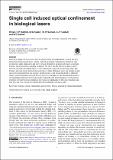Files in this item
Single cell induced optical confinement in biological lasers
Item metadata
| dc.contributor.author | Karl, M. | |
| dc.contributor.author | Dietrich, C. P. | |
| dc.contributor.author | Schubert, M. | |
| dc.contributor.author | Samuel, I. D. W. | |
| dc.contributor.author | Turnbull, G. A. | |
| dc.contributor.author | Gather, M. C. | |
| dc.date.accessioned | 2017-02-06T10:30:14Z | |
| dc.date.available | 2017-02-06T10:30:14Z | |
| dc.date.issued | 2017-03-01 | |
| dc.identifier | 247703470 | |
| dc.identifier | 21288fbc-fd3c-41c0-82fc-91b8461ce05c | |
| dc.identifier | 000415182400001 | |
| dc.identifier | 85011960864 | |
| dc.identifier | 000415182400001 | |
| dc.identifier.citation | Karl , M , Dietrich , C P , Schubert , M , Samuel , I D W , Turnbull , G A & Gather , M C 2017 , ' Single cell induced optical confinement in biological lasers ' , Journal of Physics D : Applied Physics , vol. 50 , no. 8 , 084005 . https://doi.org/10.1088/1361-6463/aa5367 , https://doi.org/10.1088/1361-6463/aa5367 | en |
| dc.identifier.issn | 0022-3727 | |
| dc.identifier.other | ORCID: /0000-0002-2132-7091/work/31037438 | |
| dc.identifier.other | ORCID: /0000-0002-4857-5562/work/47136478 | |
| dc.identifier.other | ORCID: /0000-0002-8739-4852/work/36937595 | |
| dc.identifier.uri | https://hdl.handle.net/10023/10235 | |
| dc.description | We acknowledge financial support from the European Research Council (ERC StG ABLASE, 640012), the Scottish Funding Council (via SUPA) and the European Union Marie Curie Career Integration Grant (PCIG12-GA-2012-334407). M.K. acknowledges funding from the EPSRC DTG (EP/M506631/1). M.S. acknowledges funding from the European Commission for a Marie Sklodowska-Curie Individual Fellowship (659213). I.D.W.S. acknowledges funding from a Royal Society Wolfson research merit award. | en |
| dc.description.abstract | Biological single cell lasers have shown great potential for fundamental research and next generation sensing applications. In this study, the potential of fluorescent biological cells as refractive index landscapes and active optical elements is investigated using a combined Fourier- and hyperspectral imaging technique. We show that the refractive index contrast between cell and surrounding leads to three dimensional confinement of photons inside living cells. The Fourier- and real-space emission characteristics of these biological lasers are closely related and can be predicted from one another. Investigations of the lasing threshold for different energy and momentum position in Fourier-space give insight into the fundamental creation of longitudinal and transverse lasing modes within the cell. These findings corroborate the potential of living biological materials for precision engineering of photonic structures and may pave the way towards low threshold polariton lasing from single cells. | |
| dc.format.extent | 9 | |
| dc.format.extent | 4428585 | |
| dc.language.iso | eng | |
| dc.relation.ispartof | Journal of Physics D : Applied Physics | en |
| dc.subject | Biolaser | en |
| dc.subject | Optical confinement | en |
| dc.subject | Microcavities | en |
| dc.subject | Fourier imaging | en |
| dc.subject | Hyperspectral imaging | en |
| dc.subject | QC Physics | en |
| dc.subject | QH301 Biology | en |
| dc.subject | T Technology | en |
| dc.subject | DAS | en |
| dc.subject.lcc | QC | en |
| dc.subject.lcc | QH301 | en |
| dc.subject.lcc | T | en |
| dc.title | Single cell induced optical confinement in biological lasers | en |
| dc.type | Journal article | en |
| dc.contributor.sponsor | European Research Council | en |
| dc.contributor.sponsor | European Commission | en |
| dc.contributor.sponsor | European Commission | en |
| dc.contributor.sponsor | The Royal Society | en |
| dc.contributor.institution | University of St Andrews. School of Physics and Astronomy | en |
| dc.contributor.institution | University of St Andrews. Condensed Matter Physics | en |
| dc.contributor.institution | University of St Andrews. Biomedical Sciences Research Complex | en |
| dc.identifier.doi | 10.1088/1361-6463/aa5367 | |
| dc.description.status | Peer reviewed | en |
| dc.identifier.grantnumber | 640012 | en |
| dc.identifier.grantnumber | PCIG12-GA-2012-334407 | en |
| dc.identifier.grantnumber | 659213 | en |
| dc.identifier.grantnumber | en |
This item appears in the following Collection(s)
Items in the St Andrews Research Repository are protected by copyright, with all rights reserved, unless otherwise indicated.

